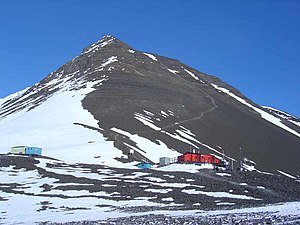Alexander I Island
| Alexander I Island | |
|---|---|
| Satellite image of the Alexander I Island | |
| Waters | Bellingshausen Lake |
| Geographical location | 71 ° 0 ′ S , 70 ° 0 ′ W |
| length | 378 km |
| width | 200 km |
| surface | 49,070 km² |
| Highest elevation |
Mount Stephenson 2987 m |
| Residents | uninhabited |
| main place | Fossil Bluff (summer station) |
| Fossil Bluff Station | |
The Alexander-I-Insel (also called Alexanderinsel in analogy to English ) is the largest island in Antarctica with an area of 49,000 km² . It is located off the west coast of the Antarctic Peninsula in the Bellingshausen Sea and extends over about 378 km in length and 200 km in width. Its coastline is about 2185 km. The island is connected to the continent of Antarctica by the ice shelf of the George VI Sound and is therefore difficult to identify as an island on satellite photos. In fact, it is only about 20 km off the Antarctic coast, from which it is separated by the aforementioned sound. The climate on Alexander I Island is polar according to its geographical location and it is practically completely icy.
geography
The Alexander-I-Insel rises in the Douglas Range up to 2987 m . The Wilkins Ice Shelf is located off the west coast of the island, between Latady , Charcot and Rothschild Islands . The southwest of the Alexander I Island is divided into various peninsulas by numerous bays. The two largest of these peninsulas are the Beethoven Peninsula in the southwest and the Monteverdi Peninsula in the extreme south, between which the Bach Ice Shelf extends.
In the southeast of the island is Lake Hodgson , a former subglacial lake that lay under a 500 m thick layer of ice 10,500 years ago. Today the thickness of its ice cover is only 3.6 to 4.0 m, depending on the season. In 2013, evidence was provided on a drill core from the lake's sediment that it also harbored life in its subglacial phase.
history
The Alexander Island was on 28 January 1821 by Fabian Gottlieb von Bellingshausen under the first Russian discovers South Pole and after the Russian Czar I. Alexander named. Until 1940 it was assumed that the area belonged to the Antarctic mainland , which is why the name Alexander I Land is occasionally used . Today Argentina , Chile and the United Kingdom are making territorial claims to the island, but these are not recognized internationally. Great Britain has had Fossil Bluff station on the island since 1961 .
Web links
Individual evidence
- ↑ David A. Pearce, Dominic A. Hodgson, Michael AS Thorne, Gavin Burns, Charles S. Cockell: Preliminary Analysis of Life within a Former Subglacial Lake Sediment in Antarctica (PDF; 753 kB). In: Diversity 5, 2013, pp. 680–702 (English), doi : 10.3390 / d5030680



